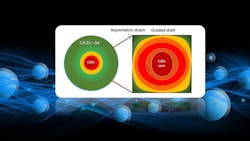The Science
Tiny light sources could advance sensors, quantum communication, bioimaging, and medical diagnostic tools. To develop these nano light bulbs, researchers are looking to quantum dots, little bits of semiconducting materials. One problem with “standard” quantum dots, though, is that the emitted light isn’t stable. Researchers have made progress in finding ways to reduce blinking in light emission intensity but other aspects of light emission such as color still fluctuate. In this study, by squeezing the emitting core during synthesis, researchers created dots that emit extraordinarily stable light that’s well suited for scientific needs.
The Impact
This study points to the potential of a new method of quantum dot synthesis. Essentially, by squeezing, this method creates quantum dots that produce highly stable light. Also, this method could offer flexible modification and control of light-emitting properties. The strained dots represent a viable alternative to today’s nanoscale light sources. The dots could lead to advances in single particle nanoscale light sources for use in optical quantum circuits, ultra-high-resolution sensors, and medical nanomarkers.
Summary
Modern synthesis techniques produce nearly ideal quantum-dot light emitters, which are used in quantum-dot displays and TV sets. But what if a single quantum dot could be a light source? These tiny light bulbs could benefit optical quantum circuits, ultrasensitive sensors, bioimaging tools, and medical diagnostics. To create such single-particle light sources, researchers need highly stable quantum dots that don’t blink and have stable and controllable emission color. A team based at Los Alamos National Laboratory did just that. They devised a way to create quantum dots that don’t blink with stable emission spectra by “squeezing” the emitting core of the dot during synthesis. Their strain-engineering approach modifies the structures of electronic states of a quantum dot and, thereby, its light-emitting properties. The resulting dots emit steady light and have a dramatic narrowing of the emission linewidth, which becomes smaller than the room-temperature thermal energy. The spectral stability achieved is comparable to that of tiny light emitters made via sophisticated, vacuum-based techniques. This suggests that colloidal quantum dots synthesized through strain engineering represent a viable alternative to presently employed nanoscale light sources. In addition to exhibiting comparable (or even improved) performance, these dots could offer unprecedented flexibility in manipulating their emission color combined with compatibility with virtually any substrate or embedding medium as well as various chemical and biological environments.

